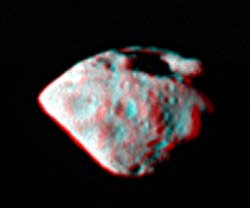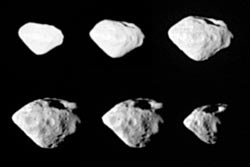Rosetta's close look at a “diamond in the sky”
08 Sep 2008
 The European Space Agency (ESA) obtained the first images of an asteroid 360 million km (224 million miles) from Earth, taken by its probe Rosetta. The probe's trajectory is designed to allow it to achieve close encounters with comets and asteroids the data from which will help scientists understand the origins of planets.
The European Space Agency (ESA) obtained the first images of an asteroid 360 million km (224 million miles) from Earth, taken by its probe Rosetta. The probe's trajectory is designed to allow it to achieve close encounters with comets and asteroids the data from which will help scientists understand the origins of planets.
On Saturday, Rosetta, flew by asteroid 2867 Steins, a small body in the main asteroid belt. The flyby, according to ESA, allowed the probe to collect a wealth of information about this rare type of asteroid. The probe came as close as 800 km to Steins.
 |
| Steins in 3-D Credits: ESA ©2008 MPS for OSIRIS Team |
According to the European Space Operations Centre (ESOC) in Darmstadt, Germany, Rosetta was not in communication link during the flyby operations, as its antenna had to be turned away from Earth. At a distance of about 2.41 AU (360 million kilometres) from Earth, telemetry signals from the probe took 20 minutes to reach the ground.
ESA describes Steins as a small asteroid of irregular shape, with a diameter of only 4.6 km. It belongs to the rare class of E-type asteroids, which had not been directly observed by an interplanetary spacecraft before. Such asteroids are quite small in size and orbit and are mostly found in the inner part of the main asteroid belt located between Mars and Jupiter.
An ESA statement said that these asteroids probably originate from the mantle of larger asteroids destroyed in the early history of the Solar System, and are thought to be composed mainly of silicate minerals with little or no iron content.
According to ESA, the data collected by Rosetta will be analysed over the coming days and weeks and it is expected that it will help in unveiling the true nature of Steins.
Rosetta's study of minor bodies, such as asteroids, is expected to open up a new window onto the early history of our solar system, giving us a better understanding of the origins and evolution of the planets. Rosetta's data will also allow a better interpretation of asteroid data collected from the ground.
2867 Steins
"Steins looks like a diamond in the sky," said Uwe Keller, principal investigator for the OSIRIS imaging system from the Max Planck Institut Fuer Sonnensystemforschung, Lindau.
Visible in the image are several small craters on the asteroid, and two huge ones, one of which is 2 km in diameter, indicating that the asteroid must be very old.
The images are 50 to 60 pixels in diameter, enough to characterise the shape and other characteristics of the body of the asteroid.
 |
| Steins-FlyBy Credits: ESA ©2008 MPS for OSIRIS Team |
The chain is composed of about 7 craters. To determine the age of the asteroid, a count of the craters on the asteroid's surface has been started (the more the number of craters, the older the asteroid). So far, 23 craters have been spotted.
From the images, scientists will try and understand why the asteroid is unusually bright, and how fine grains of the surface regolith are. This will tell them more about how the asteroid formed.
Gerhard Schwehm, Mission Manager for Rosetta said, "It looks like a typical asteroid, but it is really fascinating how much we can learn from just the images. This is our first science highlight; we certainly have a lot of promising science ahead of us. I'm already looking forward to encountering our next diamond in the sky, the much bigger Lutetia."
The OSIRIS imaging system's Wide Angle Camera (WAC) worked perfectly through the fly-by.
Science team members noted that the Narrow Angle Camera (NAC) appears to have switched to safe mode a few minutes before closest approach, but switched back on after a few hours. The software is programmed to switch to safe mode when certain parameter thresholds are crossed to protect the camera. The team will concentrate investigating the reasons for this anomaly once the science data has been analysed.
After analysis of the Rosetta data, ESA said, Steins will be one of the best-characterised asteroids so far.
Close encounters of the complex kind
Rosetta's powerful instruments have initially been focusing on the asteroid's orbital motion, rotation, shape and density. As the distance has diminished, the investigation has broadened to take in the observation of surface properties and features, and the analysis of the chemical and mineralogical composition of the terrains, as well as their relative ages and the effects of the solar wind on the surface.
At its closest approach, Rosetta flew by Steins at a relative speed of 8.6 km/s. To keep the small asteroid in the field of view of its instruments, the spacecraft had to perform a rapid and highly demanding rotation manoeuvre, which had been successfully rehearsed in March this year.
"Steins might be small, but we're making big science here", said Dr David Southwood, ESA's Director of Science and Robotic Exploration. "The better we learn to know the different kinds of asteroids, the better we will understand our origins in the past. Moreover, when such Solar System wanderers escape from the belt they could become a threat to Earth. The better we know them, the better we will be able to mitigate the risks some of them might present in the future."
"Rosetta performed very well all along," Southwood continued. " This was a complex manoeuvre to keep such a small target in sight, but the spacecraft came through with flying colours. Now we are even more confident in its capacity to conduct the complex tasks that await it at comet Churyumov-Gerasimenko."
Observations of Steins will continue until 10 September.
Since its launch by an Ariane 5 rocket on 2 March 2004, Rosetta has already travelled about 3.7 thousand million kilometres and swung by the Earth twice and Mars once for gravity-assist manoeuvres.
On 17 December this year Rosetta will reach the maximum distance from the Sun in its current orbit, and will then head back towards Earth for the next and last gravitational kick from our planet on 13 November 2009. This will give the probe its final push toward its cometary target.
On its way, Rosetta is scheduled to conduct another flyby, this time with the much larger Lutetia asteroid, on 10 July 2010.
Arrival at 67P/Churyumov-Gerasimenko is due by mid-2014. By that time the probe will have covered a distance of about 6.5 thousand million kilometres.






























